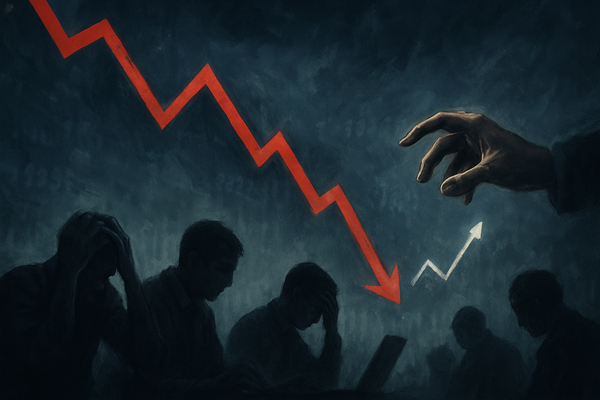Wall Street's 'Trick or Treat' Outlook: Navigating Uncertainty on Halloween 2025

As the final day of October 2025 dawns, Wall Street finds itself in a quintessential "Trick or Treat" scenario, grappling with a complex blend of bullish momentum and underlying apprehension. While the S&P 500 (NYSE: SPY) stands poised for a remarkable sixth consecutive monthly gain, defying historical seasonal trends, a palpable sense of caution permeates the market. This uncertainty is largely driven by the Federal Reserve's ambiguous monetary policy signals, mixed corporate earnings reports, and persistent macroeconomic headwinds, leaving investors to weigh the potential for further gains against the specter of economic slowdowns as the year-end approaches.
The immediate implications of this bifurcated sentiment are evident across various asset classes. Equity markets are experiencing selective volatility, particularly within the tech sector, while bond yields have reacted to the Fed's stance. Gold, a traditional safe haven, has seen renewed interest, and currency markets are reflecting a strengthening U.S. dollar (USD) amidst global uncertainties. This delicate balance creates a challenging environment for investors attempting to discern the true direction of the market, making Halloween 2025 a day of careful reflection rather than unbridled celebration.
A Month of Mixed Signals and Monetary Maneuvers
October 2025 has proven to be a truly "remarkable month" for financial markets, characterized by both unexpected resilience and simmering anxieties. The S&P 500's (NYSE: SPY) consistent upward trajectory, building on a strong September, has been a significant bullish signal, attracting substantial inflows into global stock funds. However, this optimism is tempered by a series of events that have injected a dose of reality and caution into investor sentiment.
The Federal Reserve (Fed) stands as a central player in this narrative. On October 29, 2025, the Fed implemented its second 25-basis-point rate cut of the year, bringing the benchmark rate to 3.75%-4.00%. This move was initially met with some relief, signaling the central bank's responsiveness to economic conditions. However, Chair Jerome Powell's subsequent comments introduced a significant element of uncertainty, stating that a December rate cut is "not a foregone conclusion." This hawkish pivot immediately dampened market expectations for further easing, leading to profit-taking and a re-evaluation of monetary policy trajectory.
Corporate earnings have painted a similarly mixed picture. The "Magnificent Seven" tech giants, often market bellwethers, delivered divergent results. While Apple (NASDAQ: AAPL) and Amazon (NASDAQ: AMZN) reported robust earnings, providing a boost to Nasdaq (NASDAQ: QQQ) futures, Meta Platforms (NASDAQ: META) and Microsoft (NASDAQ: MSFT) saw declines. These declines were largely attributed to investor concerns over the escalating capital expenditure required for artificial intelligence (AI) infrastructure, raising questions about the sustainability of AI-driven growth and the potential for an "AI investment bubble."
Beyond corporate reports, broader economic concerns loom large. Persistent services and shelter inflation, coupled with global trade and geopolitical events, continue to pose upside risks to overall inflation. Signs of a softening U.S. labor market, including moderating wage growth, and a potential slowdown in consumer spending, evidenced by September's retail sales estimates, further contribute to the cautious outlook. Additionally, the U.S. government shutdown, which began on October 1, 2025, has added another layer of short-term uncertainty, delaying crucial economic data releases and potentially impacting investor confidence, despite historical precedents suggesting limited long-term economic impact from such events. The confluence of these factors has left Wall Street in a "pause mode," digesting recent gains and awaiting clearer signals for the next directional move.
Companies on the Cusp: Winners and Losers in a Cautious Market
In a market characterized by both opportunity and apprehension, certain companies and sectors are positioned to either thrive or face significant headwinds. The "Trick or Treat" outlook means that while some firms deliver pleasant surprises, others might find themselves dealing with unwelcome shocks.
On the "treat" side, companies demonstrating strong, resilient earnings and those with sustainable, albeit capital-intensive, AI strategies are likely to emerge as winners. Tech giants like Apple (NASDAQ: AAPL) and Amazon (NASDAQ: AMZN), which delivered robust earnings reports, exemplify this resilience. Their ability to navigate economic uncertainties and continue innovating, particularly in areas like cloud computing (Amazon Web Services) and consumer electronics (Apple's ecosystem), positions them favorably. Furthermore, companies providing essential infrastructure or services that are less sensitive to discretionary spending slowdowns, such as utilities or certain healthcare providers, may offer a defensive play for investors. The continued strength in emerging market debt also suggests that financial institutions heavily invested in these growing economies could see benefits. Gold miners and related companies, such as Barrick Gold (NYSE: GOLD), could also benefit from gold's enhanced safe-haven status amidst geopolitical tensions and market uncertainty.
Conversely, the "trick" aspect of the market outlook poses challenges for several types of companies. Firms highly sensitive to consumer discretionary spending, especially those catering to lower-income consumers who are reportedly struggling, could face declining sales and profitability. Retailers and hospitality companies might see their margins squeezed if consumer spending continues to slow. Companies with high growth expectations but currently unprofitable models, particularly in speculative tech areas, could suffer as investors prioritize profitability and sustainable cash flow in a higher interest rate environment. The concerns over an "AI investment bubble" directly impact companies like Meta Platforms (NASDAQ: META) and Microsoft (NASDAQ: MSFT), which, despite strong underlying businesses, faced investor scrutiny over their escalating AI capital expenditures. While AI is a long-term growth driver, the immediate costs and unclear return on investment for some projects can weigh on short-term valuations. Additionally, any company heavily reliant on stable, low-cost debt could be negatively impacted by the Federal Reserve's cautious stance on further rate cuts, leading to higher borrowing costs.
Broader Implications and Historical Echoes
The current "Trick or Treat" sentiment on Wall Street extends far beyond individual company performance, weaving into the broader tapestry of financial markets and economic trends. This period of cautious optimism reflects several wider significances that could shape the market landscape for months to come.
Firstly, the Federal Reserve's nuanced stance on monetary policy underscores a pivotal moment for global central banking. The combination of a rate cut with Chair Powell's cautionary remarks signals an agile, data-dependent approach, but one that introduces greater uncertainty regarding the terminal rate and the pace of future adjustments. This has ripple effects on global capital flows, influencing the attractiveness of U.S. assets relative to international markets and potentially impacting sovereign bond yields worldwide. The strengthening U.S. dollar (USD) and the continued weakness of the Japanese Yen (JPY) are direct consequences, pressuring central banks like the Bank of Japan to consider their own policy responses.
Secondly, the evolving narrative around Artificial Intelligence (AI) investment is a critical industry trend. While AI is undeniably a transformative technology, the market's reaction to the capital expenditure required by giants like Meta Platforms (NASDAQ: META) and Microsoft (NASDAQ: MSFT) highlights a growing discernment among investors. This suggests a potential shift from pure growth speculation to a demand for tangible returns on AI investments, potentially leading to a more mature, but also more selective, funding environment for AI startups and established tech firms alike. This could lead to consolidation in the AI sector and a greater focus on profitable applications rather than just technological advancement.
Thirdly, the U.S. government shutdown, while often short-lived, serves as a recurring reminder of fiscal instability. Historically, shutdowns have had limited sustained economic impact, but they introduce an element of political risk and can delay critical economic data releases, clouding the outlook for businesses and investors. This event fits into a broader pattern of legislative gridlock that can periodically inject uncertainty into the market, prompting comparisons to similar political impasses in previous decades. The current situation also highlights the ongoing debate around national debt and fiscal responsibility, which could have long-term implications for bond markets and investor confidence in U.S. assets.
Finally, the persistent inflationary pressures, particularly in services and shelter, challenge the narrative of rapidly receding inflation. This indicates that while commodity prices may have stabilized, underlying structural factors continue to exert upward pressure on costs, potentially forcing the Fed to maintain a higher-for-longer interest rate stance than initially anticipated. This scenario has historical parallels to periods of stagflation or prolonged inflationary battles, where central banks struggled to balance price stability with economic growth, reminding investors of the delicate equilibrium required for sustained market prosperity.
What Comes Next: Navigating the Path Ahead
As Wall Street moves beyond Halloween 2025, the market's "Trick or Treat" outlook sets the stage for a period of careful navigation, with both short-term challenges and long-term opportunities emerging. The immediate focus will undoubtedly be on the Federal Reserve's next moves and the incoming economic data.
In the short term, investors will be closely watching for clarity on the Fed's December meeting, particularly any further guidance on interest rate policy. Chair Powell's previous remarks have opened the door for either a pause or another cut, making every economic indicator, from inflation reports to labor market statistics, crucial for market direction. The resolution of the U.S. government shutdown will also be key, as a prolonged impasse could further dampen consumer and business confidence. Companies will need to adapt strategically, potentially by re-evaluating capital expenditure plans, particularly those heavily invested in AI infrastructure, to ensure sustainable growth and profitability in a higher-for-longer interest rate environment. Retailers will be keenly focused on holiday spending trends, as consumer resilience will be tested in the face of moderating wage growth and potentially reduced savings.
Looking further ahead, the long-term trajectory of AI will continue to be a dominant theme. While the initial "AI investment bubble" concerns may lead to a more disciplined approach, the underlying transformative power of AI remains. Companies that can effectively integrate AI to enhance productivity, drive innovation, and create new revenue streams, rather than merely incurring high costs, will be best positioned for sustained success. This could lead to strategic pivots where firms prioritize specific, high-ROI AI applications. Market opportunities may emerge in sectors that benefit from structural shifts, such as renewable energy or healthcare innovation, which often exhibit less sensitivity to short-term economic fluctuations. Conversely, challenges will persist for highly leveraged companies or those in industries facing secular decline, as a cautious market environment can exacerbate existing vulnerabilities.
Potential scenarios range from a "soft landing," where inflation gradually recedes without a significant economic downturn, to a more challenging "hard landing" or even a period of stagflation if inflationary pressures prove more stubborn and growth falters. The market's ability to absorb these possibilities will depend heavily on the adaptability of corporations, the prudence of monetary policy, and the stability of the geopolitical landscape. Investors should anticipate continued volatility and a greater emphasis on fundamental analysis and risk management in the coming months.
A Comprehensive Wrap-up: Key Takeaways and Future Watchpoints
The Halloween 2025 market outlook, dubbed "Trick or Treat," encapsulates a period of profound uncertainty balanced by pockets of enduring strength. The key takeaway is a financial landscape defined by divergence: resilient performance in some sectors contrasted with broader economic anxieties, and a central bank navigating a delicate path between inflation control and growth support.
Moving forward, the market is likely to remain in a state of flux, characterized by elevated volatility and a heightened sensitivity to economic data and central bank communications. The era of consistently low interest rates appears to be firmly in the past, necessitating a re-evaluation of valuation models and investment strategies. Companies that can demonstrate strong balance sheets, consistent profitability, and a clear path to generating returns on their investments, particularly in burgeoning fields like AI, will be favored. Conversely, firms reliant on cheap debt or speculative growth models may face increasing scrutiny and pressure.
The lasting impact of this period will likely be a more discerning market, one that prioritizes fundamental strength and sustainable growth over hype. Investors should prepare for a potentially more challenging environment where active management and thorough due diligence become even more critical.
In the coming months, investors should closely watch several key indicators:
- Federal Reserve's forward guidance: Any shifts in tone or policy decisions regarding interest rates.
- Inflation data: Particularly services and shelter inflation, to gauge the persistence of price pressures.
- Labor market reports: For signs of continued softening or unexpected resilience.
- Consumer spending trends: Especially during the critical holiday season, to assess the health of the U.S. consumer.
- Geopolitical developments: Any escalation or de-escalation of trade tensions or global conflicts.
- AI investment returns: How major tech companies demonstrate profitability from their AI expenditures.
By carefully monitoring these factors, investors can better navigate the "Tricks" and capitalize on the "Treats" that Wall Street may offer in the evolving economic landscape.
This content is intended for informational purposes only and is not financial advice



